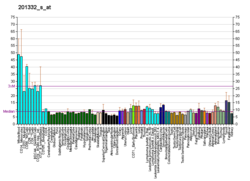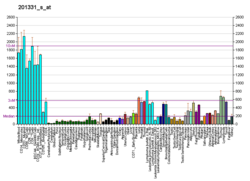STAT6
Signal transducer and activator of transcription 6 (STAT6) is a transcription factor that belongs to the Signal Transducer and Activator of Transcription (STAT) family of proteins.[5] The proteins of STAT family transmit signals from a receptor complex to the nucleus and activate gene expression. Similarly as other STAT family proteins, STAT6 is also activated by growth factors and cytokines. STAT6 is mainly activated by cytokines interleukin-4 and interleukin-13.[5]
Molecular biology
[edit]In the human genome, STAT6 protein is encoded by the STAT6 gene, located on the chromosome 12q13.3-q14.1.[6] The gene encompasses over 19 kb and consists of 23 exons.[7] STAT6 shares structural similarity with the other STAT proteins and is composed of the N-terminal domain, DNA binding domain, SH3- like domain, SH2 domain and transactivation domain (TAD).[7]
STAT proteins are activated by the Janus family (JAKs) tyrosine kinases in response to cytokine exposure.[8] STAT6 is activated by cytokines interleukin-4 (IL-4), and interleukin-13 (IL-13) with their receptors that both contain the α subunit of the IL-4 receptor (IL-4Rα).[8] Tyrosine phosporylation of STAT6 after stimulation by IL-4 results in the formation of STAT6 homodimers that bind specific DNA elements via a DNA-binding domain.[5][9]
Function
[edit]STAT6-mediated signaling pathway is required for the development of T-helper type 2 (Th2) cells and Th2 immune response.[8] Expression of Th2 cytokines, including IL-4, IL-13, and IL-5, was reduced in STAT6-deficient mice.[5] STAT 6 protein is crucial in IL4 mediated biological responses. It was found that STAT6 induce the expression of BCL2L1/BCL-X(L), which is responsible for the anti-apoptotic activity of IL4. IL-4 stimulates the phosphorylation of IL-4 receptor, which recruits cytosolic STAT6 by its SH2 domain and STAT6 is phosphorylated on tyrosine 641 (Y641) by JAK1, which results in the dimerization and nuclear translocation of STAT6 to activate target genes.[10] Knockout studies in mice suggested the roles of this gene in differentiation of T helper 2 (Th2), expression of cell surface markers, and class switch of immunoglobulins.[11]
Activation of STAT6 signaling pathway is necessary in macrophage function, and is required for the M2 subtype activation of macrophages.[12][13][14] STAT6 protein also regulates other transcription factor as Gata3, which is important regulator of Th2 differentiation.[5] STAT6 is also required for the development of IL-9-secreting T cells.[5]
STAT6 also plays a critical role in Th2 lung inflammatory responses including clearance of parasitic infections and in the pathogenesis of asthma.[8] Th2-cell derived cytokines as IL-4 and IL-13 induce the production of IgE which is a major mediator in allergic response.[9] Association studies searching for relation of polymorphisms in STAT6 with IgE level or asthma discovered a few polymorphisms significantly associated with examined traits. Only two polymorphisms showed repeatedly significant clinical association and/or functional effect on STAT6 function (GT repeats in exon 1 and rs324011 polymorphism in intron 2).[7]
Interactions
[edit]STAT6 has been shown to interact with:
- CREB-binding protein,[15][16]
- EP300,[15]
- IRF4,[17]
- NFKB1,[18]
- Nuclear receptor coactivator 1,[16][19] and
- SND1.[20]
Pathology
[edit]- Gene fusion
- Recurrent somatic fusions of the two genes, NGFI-A–binding protein 2 (NAB2) and STAT6, located at chromosomal region 12q13, have been identified in solitary fibrous tumors.[21]
- Amplification
- STAT6 is amplified in a subset of dedifferentiated liposarcoma.[22]
See also
[edit]References
[edit]- ^ a b c GRCh38: Ensembl release 89: ENSG00000166888 – Ensembl, May 2017
- ^ a b c GRCm38: Ensembl release 89: ENSMUSG00000002147 – Ensembl, May 2017
- ^ "Human PubMed Reference:". National Center for Biotechnology Information, U.S. National Library of Medicine.
- ^ "Mouse PubMed Reference:". National Center for Biotechnology Information, U.S. National Library of Medicine.
- ^ a b c d e f Goenka S, Kaplan MH (May 2011). "Transcriptional regulation by STAT6". Immunologic Research. 50 (1): 87–96. doi:10.1007/s12026-011-8205-2. PMC 3107597. PMID 21442426.
- ^ Patel BK, Keck CL, O'Leary RS, Popescu NC, LaRochelle WJ (September 1998). "Localization of the human stat6 gene to chromosome 12q13.3-q14.1, a region implicated in multiple solid tumors". Genomics. 52 (2): 192–200. doi:10.1006/geno.1998.5436. PMID 9782085.
- ^ a b c Godava M, Vrtel R, Vodicka R (June 2013). "STAT6 - polymorphisms, haplotypes and epistasis in relation to atopy and asthma". Biomedical Papers of the Medical Faculty of the University Palacky, Olomouc, Czechoslovakia. 157 (2): 172–80. doi:10.5507/bp.2013.043. PMID 23752766.
- ^ a b c d Walford HH, Doherty TA (October 2013). "STAT6 and lung inflammation". JAK-STAT. 2 (4): e25301. doi:10.4161/jkst.25301. PMC 3876430. PMID 24416647.
- ^ a b Leek JP, Hamlin PJ, Bell SM, Lench NJ (1997). "Assignment of the STAT6 gene (STAT6) to human chromosome band 12q13 by in situ hybridization". Cytogenetics and Cell Genetics. 79 (3–4): 208–9. doi:10.1159/000134723. PMID 9605853.
- ^ Chen H, Sun H, You F, Sun W, Zhou X, Chen L, et al. (October 2011). "Activation of STAT6 by STING is critical for antiviral innate immunity". Cell. 147 (2): 436–46. doi:10.1016/j.cell.2011.09.022. PMID 22000020.
- ^ "STAT6 signal transducer and activator of transcription 6 [Homo sapiens (human)] - Gene - NCBI". www.ncbi.nlm.nih.gov. Retrieved 2021-05-01.
- ^ Binnemars-Postma K, Bansal R, Storm G, Prakash J (February 2018). "Targeting the Stat6 pathway in tumor-associated macrophages reduces tumor growth and metastatic niche formation in breast cancer". FASEB Journal. 32 (2): 969–978. doi:10.1096/fj.201700629R. PMID 29066614. S2CID 3342014.
- ^ Gong M, Zhuo X, Ma A (June 2017). "STAT6 Upregulation Promotes M2 Macrophage Polarization to Suppress Atherosclerosis". Medical Science Monitor Basic Research. 23: 240–249. doi:10.12659/msmbr.904014. PMC 5484610. PMID 28615615.
- ^ Waqas SF, Ampem G, Röszer T (2019). "Analysis of IL-4/STAT6 Signaling in Macrophages". Nuclear Receptors. Methods in Molecular Biology. Vol. 1966. pp. 211–224. doi:10.1007/978-1-4939-9195-2_17. ISBN 978-1-4939-9194-5. PMID 31041750. S2CID 141465649.
- ^ a b McDonald C, Reich NC (July 1999). "Cooperation of the transcriptional coactivators CBP and p300 with Stat6". Journal of Interferon & Cytokine Research. 19 (7): 711–22. doi:10.1089/107999099313550. PMID 10454341.
- ^ a b Litterst CM, Pfitzner E (December 2001). "Transcriptional activation by STAT6 requires the direct interaction with NCoA-1". The Journal of Biological Chemistry. 276 (49): 45713–21. doi:10.1074/jbc.M108132200. PMID 11574547.
- ^ Gupta S, Jiang M, Anthony A, Pernis AB (December 1999). "Lineage-specific modulation of interleukin 4 signaling by interferon regulatory factor 4". The Journal of Experimental Medicine. 190 (12): 1837–48. doi:10.1084/jem.190.12.1837. PMC 2195723. PMID 10601358.
- ^ Shen CH, Stavnezer J (June 1998). "Interaction of stat6 and NF-kappaB: direct association and synergistic activation of interleukin-4-induced transcription". Molecular and Cellular Biology. 18 (6): 3395–404. doi:10.1128/mcb.18.6.3395. PMC 108921. PMID 9584180.
- ^ Litterst CM, Pfitzner E (September 2002). "An LXXLL motif in the transactivation domain of STAT6 mediates recruitment of NCoA-1/SRC-1". The Journal of Biological Chemistry. 277 (39): 36052–60. doi:10.1074/jbc.M203556200. PMID 12138096.
- ^ Yang J, Aittomäki S, Pesu M, Carter K, Saarinen J, Kalkkinen N, et al. (September 2002). "Identification of p100 as a coactivator for STAT6 that bridges STAT6 with RNA polymerase II". The EMBO Journal. 21 (18): 4950–8. doi:10.1093/emboj/cdf463. PMC 126276. PMID 12234934.
- ^ Kabbinavar FF, Hambleton J, Mass RD, Hurwitz HI, Bergsland E, Sarkar S (June 2005). "Combined analysis of efficacy: the addition of bevacizumab to fluorouracil/leucovorin improves survival for patients with metastatic colorectal cancer". Journal of Clinical Oncology. 23 (16): 3706–12. doi:10.1200/JCO.2005.00.232. PMID 15867200.
- ^ Doyle LA, Tao D, Mariño-Enríquez A (September 2014). "STAT6 is amplified in a subset of dedifferentiated liposarcoma". Modern Pathology. 27 (9): 1231–7. doi:10.1038/modpathol.2013.247. PMID 24457460.
Further reading
[edit]- Jiang H, Harris MB, Rothman P (June 2000). "IL-4/IL-13 signaling beyond JAK/STAT". The Journal of Allergy and Clinical Immunology. 105 (6 Pt 1): 1063–70. doi:10.1067/mai.2000.107604. PMID 10856136.
- Kisseleva T, Bhattacharya S, Braunstein J, Schindler CW (February 2002). "Signaling through the JAK/STAT pathway, recent advances and future challenges". Gene. 285 (1–2): 1–24. doi:10.1016/S0378-1119(02)00398-0. PMID 12039028.
- Hou J, Schindler U, Henzel WJ, Ho TC, Brasseur M, McKnight SL (September 1994). "An interleukin-4-induced transcription factor: IL-4 Stat". Science. 265 (5179): 1701–6. Bibcode:1994Sci...265.1701H. doi:10.1126/science.8085155. PMID 8085155.
- Takeda K, Tanaka T, Shi W, Matsumoto M, Minami M, Kashiwamura S, et al. (April 1996). "Essential role of Stat6 in IL-4 signalling". Nature. 380 (6575): 627–30. Bibcode:1996Natur.380..627T. doi:10.1038/380627a0. PMID 8602263. S2CID 4340375.
- Shimoda K, van Deursen J, Sangster MY, Sarawar SR, Carson RT, Tripp RA, et al. (April 1996). "Lack of IL-4-induced Th2 response and IgE class switching in mice with disrupted Stat6 gene". Nature. 380 (6575): 630–3. Bibcode:1996Natur.380..630S. doi:10.1038/380630a0. PMID 8602264. S2CID 4334441.
- Kotanides H, Reich NC (October 1996). "Interleukin-4-induced STAT6 recognizes and activates a target site in the promoter of the interleukin-4 receptor gene". The Journal of Biological Chemistry. 271 (41): 25555–61. doi:10.1074/jbc.271.41.25555. PMID 8810328.
- Mikita T, Campbell D, Wu P, Williamson K, Schindler U (October 1996). "Requirements for interleukin-4-induced gene expression and functional characterization of Stat6". Molecular and Cellular Biology. 16 (10): 5811–20. doi:10.1128/mcb.16.10.5811. PMC 231582. PMID 8816495.
- Shen CH, Stavnezer J (June 1998). "Interaction of stat6 and NF-kappaB: direct association and synergistic activation of interleukin-4-induced transcription". Molecular and Cellular Biology. 18 (6): 3395–404. doi:10.1128/mcb.18.6.3395. PMC 108921. PMID 9584180.
- Leek JP, Hamlin PJ, Bell SM, Lench NJ (1998). "Assignment of the STAT6 gene (STAT6) to human chromosome band 12q13 by in situ hybridization". Cytogenetics and Cell Genetics. 79 (3–4): 208–9. doi:10.1159/000134723. PMID 9605853.
- Mikita T, Kurama M, Schindler U (August 1998). "Synergistic activation of the germline epsilon promoter mediated by Stat6 and C/EBP beta". Journal of Immunology. 161 (4): 1822–8. doi:10.4049/jimmunol.161.4.1822. PMID 9712049. S2CID 82211469.
- Patel BK, Keck CL, O'Leary RS, Popescu NC, LaRochelle WJ (September 1998). "Localization of the human stat6 gene to chromosome 12q13.3-q14.1, a region implicated in multiple solid tumors". Genomics. 52 (2): 192–200. doi:10.1006/geno.1998.5436. PMID 9782085.
- Zhu M, John S, Berg M, Leonard WJ (January 1999). "Functional association of Nmi with Stat5 and Stat1 in IL-2- and IFNgamma-mediated signaling". Cell. 96 (1): 121–30. doi:10.1016/S0092-8674(00)80965-4. PMID 9989503. S2CID 14758136.
- McDonald C, Reich NC (July 1999). "Cooperation of the transcriptional coactivators CBP and p300 with Stat6". Journal of Interferon & Cytokine Research. 19 (7): 711–22. doi:10.1089/107999099313550. PMID 10454341.
- Harris MB, Chang CC, Berton MT, Danial NN, Zhang J, Kuehner D, et al. (October 1999). "Transcriptional repression of Stat6-dependent interleukin-4-induced genes by BCL-6: specific regulation of iepsilon transcription and immunoglobulin E switching". Molecular and Cellular Biology. 19 (10): 7264–75. doi:10.1128/mcb.19.10.7264. PMC 84719. PMID 10490661.
- Gupta S, Jiang M, Pernis AB (October 1999). "IFN-alpha activates Stat6 and leads to the formation of Stat2:Stat6 complexes in B cells". Journal of Immunology. 163 (7): 3834–41. doi:10.4049/jimmunol.163.7.3834. PMID 10490982. S2CID 255676952.
- Gupta S, Jiang M, Anthony A, Pernis AB (December 1999). "Lineage-specific modulation of interleukin 4 signaling by interferon regulatory factor 4". The Journal of Experimental Medicine. 190 (12): 1837–48. doi:10.1084/jem.190.12.1837. PMC 2195723. PMID 10601358.
- Daniel C, Salvekar A, Schindler U (May 2000). "A gain-of-function mutation in STAT6". The Journal of Biological Chemistry. 275 (19): 14255–9. doi:10.1074/jbc.C000129200. PMID 10747856.
- Arinobu Y, Sugimoto R, Akaiwa M, Arima K, Otsuka T, Hamasaki N, et al. (October 2000). "Augmentation of signal transducer and activation of transcription (STAT)6 and STAT3 expression in stimulated B and T cells". Biochemical and Biophysical Research Communications. 277 (2): 317–24. doi:10.1006/bbrc.2000.3674. PMID 11032724.
- Masuda A, Matsuguchi T, Yamaki K, Hayakawa T, Yoshikai Y (July 2001). "Interleukin-15 prevents mouse mast cell apoptosis through STAT6-mediated Bcl-xL expression". The Journal of Biological Chemistry. 276 (28): 26107–13. doi:10.1074/jbc.M011475200. PMID 11369758.
External links
[edit]- STAT6+Transcription+Factor at the U.S. National Library of Medicine Medical Subject Headings (MeSH)






